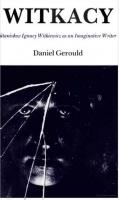Witkacy: Stanislaw Ignacy Witkiewicz as an Imaginative Writer 029595714X
The brilliant dramatist-novelist-portraitist Stanislaw Ignacy Witkiewicz made up the name Witkacy to distinguish himself
257 52 35MB
English Pages [397] Year 1981
Recommend Papers

- Author / Uploaded
- Daniel Gerould
File loading please wait...
Citation preview
KACY
oloui.s l(lw ' g"tlC)' W;lkit'w;c;. as (III I mllg;,wl;W U'r;ltf
Daniel Gerould
WITKAcy I
Stanislaw Ignacy Witkiewicz as an Imaginative Writer
BY DANIEL GEROULD
UNIVERSITY OF WASHINGTON PRESS SEATTLE AND LONDON
•
WITKACY
Copyright © 1981 by the University of Washington Press Printed in the United States of America All rights reserved. No portion of this publication may be reproduced or transmitted in any form or by any means, electronic or mechanical, including photocopy, recording, or any information storage or retrieval system, without permission in writing from the publisher.
Library of Congress Cataloging in Publication Data Gerould, Daniel Charles, 1928Witkacy: Stanislaw Ignacy Witkiewicz as an imaginative writer. Bibliography: p. Includes index. 1. Witkiewicz, Stanislaw Ignacy, 1885-1939Criticism and interpretation. PG 7 158. W5 22G4 891.8'5870 9 79-3872 ISBN D-295-95714-X
Endpapers: Self-portrait of Witkacy. Courtesy Qf Ewa and Stefan Okolowicz This book was published with the assistance of a grant from the National Endowment for the Humanities.
•
Contents
Preface Ackno\vledgments Chronology I.
WITKACY
2.
EARLY WORKS AND INFLUENCES:
From Cockroaches to The Demonic Woman 3·
XIII
xv 3
23
PLA YS OF APPRENTICESHIP:
Experiments with Form, Pure and Impure
47
Maciej Korbowa and Bellatrix (1918)
48 63
The Pragmatists (1919) Tumor Brainiowicz (1920) Mr. Price, or Tropical Madness (1920) The New Deliverance (1920) They (1920) Miss Tootli-Pootli (1920) In a Small Country House (192 I) The Independence of Triangles (192 I) 4·
IX
76 87 100 II4 121 124 128
MASTERY OF FORM:
Non-Euclidean and Spherical
135
Metaphysics of a Two-Headed Calf (192 I)
13 6
Gyubal Wahazar (192 I) The Water Hen (1921) The Anonymous Work (192 I)
150
The Cuttlefish (1922) Dainty Shapes and Hairy Apes (19 22 )
16 7 177 18 5 199
v
Contents
VI
5·
6.
PAST MASTERY AND SELF-DESTRUCTIVE FORM:
The Triumph of Nothingness
207
Jan Madej Karol Hellcat (1922) The Madman and the Nun (1923) The Crazy Locomotive (1923) Janulka, Daughter of Fizdejko (1923) The Mother (1924) The Beelzebub Sonata (1925)
209 212 224 234
.'
243 253
JETTISONING PURE FORM: MIXED BAGS AND GARGANTUAN DISPROPORTIONS:
7·
8.
Witkaey and the Novel
26 7
Farewell to Autumn (1927) Insatiability (1930) The Only Way Out (1931-33)
269 29 1 3 16
DEMYTHIFICATIONS AND THEATRICALISM: The Shoemakers (1934)
319
WITKACY'S DRAMATIC IMAGINATION AND MODERN POLISH DRAMA
339
Bibliography
343
Index
35 1
Ilhistrations
following page 44
\Vitkacy as a child Father and son, about 1911 Multi p Ie self-portra it, 1914-17 \Vitkacy, with one of his own paintings in the background, around 1913 "Malinowski Facing the Fear of Life," portrait by Witkiewicz, around 1913 Irena Solska, portrait by \Vitkiewicz, 1926 \Vitkiewicz, photograph, 1930S \Vitkiewicz, self-portrait, 1930 "The Prince of Darkness Tempts Saint Theresa with the Aid of a Waiter from Budapest," charcoal composition by Witkiewicz, around 1913 "At the Bottom," charcoal composition by Witkiewicz, 1905-10 \Vitkiewicz "faces," photographs, 1930S
following page 264 The Pragmatists, Olsztyn, 1968 Mr. Price, .L6di, 1969 The New Deliverance, New York, 1973 Metaphysics of a Two-Headed Calf, Poznan, 1928 Gyubal Wahazar,Warsaw, 1968 Gyubal Wahazar, Warsaw, 1968 The Anonymous Work, Cracow, 1967 The Mother, Cracow, 1963-64 The Beelzebub Sonata, Honolulu, 1974 Dainty Shapes and Hairy Apes, Richmond, Virginia, 1979 The Madman and the Nun, New York, 1979
VII
Vlll
Illustrations
Chapter opening illustrations: compositions by Witkiewicz
facing page
"Man with Dropsy Lying in Wait for His Wife's Lover," 190 5- 10 "The Garden of Torments," 1905-10 "The Mongolian Princess's Kiss," 1915-18 "Chimera," 1923 "Symbolic Composition with Three Figures," 1928 Drawing, 1933 " Drawing, 1933 "Dialectics of Cattle-ized Metaphysics," 1933
3 23
47 135 20 7 26 7 3 19 339
•
Preface
STANISLA W I GN ACY W ITKIEWICZ was the most remarkable and versatile artistic personality active in Poland during the first half of the twentieth century. Although he became the center of stormy controversy in his own lifetime because of his unconventional views and behavior, the enduring value of Witkiewicz's work was not perceived by his contemporaries, and true recognition has come only posthumously, first in Poland after the liberalization of 1956, then in Europe and America in the 1960s and 1970s. Now that his plays have been translated into more than a dozen languages and performed throughout the world, Witkiewicz is starting to assume his proper place as a major figure in the European avant-garde between the wars, but the full extent and nature of his accomplishments still remain to be charted and assessed. A prolific creator in many different genres, Witkiewicz left behind an immense body of paintings, dramas, novels, and prose writings. Some of these works are lost, others have never been published, and many are virtually inaccessible, having never reappeared since original publication. In this vast creation, prominent place is given to Witkiewicz's own flamboyant temperament and extraordinary experiences, as well as to his bold ideas about art, philosophy, and the history of civilization. Accordingly, in Witkiewicz's case, all boundaries between the artist's life and his work have inevitably blurred, and there is a strong temptation to interpret his creative work in toto as part of his autobiography, using the plays and novels to illustrate aspects of his character and beliefs, and emphasizing the author's theories rather than his artistry. I My aim in the present volume is, on the contrary, to present Witkiewicz primarily as an imaginative writer, and to trace his development as an artist. To do so, in an introductory study, means to view Witkiewicz the writer I. Rather than use Witkacy's works to provide data about his life and views, I have attempted to treat the author's ideas and experiences as raw materials for his art. As novelist and playwright, Witkacy dramatized himself and his own neuroses in order to create an artful - as opposed to a psychologically truthful- presentation of his own personality, and he even developed his catastrophic notions for his own artistic purposes. In this respect I follow the ideas on the relation between biography and literature set forth in Boris Tomashevsky's essay, "Literature and Biography," which can be found in Readings in Russian Poetics, ed. Ladislav Matejka and Krystyna Pomorska (Cambridge, Mass., and London: MIT Press, 1971), pp. 47-55·
IX
x
Preface
and his literary accomplishments largely on their own terms, that is, to approach his plays and novels individually as works of drama and fiction, each with a life of its own. Therefore, in this book, Witkiewicz's extensive production in other areas of artistic and intellectual en.deavor - as painter, aesthetician, theorist of the theater, polemicist, and philosopher- can only be alluded to briefly, as these illuminate his work as an imaginative writer. Witkiewicz was an original, if self-taught philosopher and a brilliant and prophetic social critic of mass culture, postindustrial society, and the rise of totaiitarianism, as well as a pioneering spokesman for a radically nonrealistic theater, which he called Pure Form. But interesting and important as his theories are, preoccupation with them has frequently impeded, rather than furthered, understanding of the plays and novels themselves, and obscured Witkiewicz's achievements in imaginative writing. Concern with his aesthetic principles leads away from the works themselves or reduces them to exemplifications of philosophical positions and expressions of personal belief. Setting aside these questions, I have undertaken a basic study of Witkiewicz's plays and novels considered chronologically in order to show the way in which his art evolved and how in actual practice he approached and resolved artistic problems. The creative process itself is one about which Witkiewicz's theory of Pure Form says almost nothing. Witkiewicz the aesthetician is unusually reticent about the genesis and composition of his own plays and novels, and in his critical writing he offers little in the way of analysis of their form or substance. His poetics remain general and abstract. 2 For these reasons, I have gone directly to the drama and fiction itself to discover Witkiewicz the creator at work and have examined his dramaturgical and fictional method by exploring structural and thematic patterns as they unfold in each play and novel. 3 It has been my intention, therefore, to seek explication of Witkiewicz's powerful artistic effects in recurring images, motifs, and techniques, refined and perfected in the course of his career as a writer, rather than to give a systematic exposition of his philosophical views. For Witkiewicz the playwright and novelist, ideas and 2. In Insatiability the avant-garde composer, Putricides Hardonne, declares that "the 'contrivance of art' ... was a problem fit for morons and aesthetic prigs." See Stanislaw Ignacy Witkiewicz, Insatiability, trans. Louis Iribarne (Urbana: University of Illinois Press, 1977), p. 159· Witkacy himself apparently shares this view, since he never discusses matters of technique and rarely offers any insight into his own creative method or the genesis and evolution of his works. My concern is precisely with the workings of Witkacy's dramatic imagination and the contrivance of his art. 3· Jerzy R. Krzyzanowski first suggested that it would be profitable to analyze Witkacy's works for their intrinsic dramatic values. Pointing out thilt little attempt has been made to focus on Witkacy's technique because of emphasis on his philosophy and aesthetic theories as well as on his biography, Krzyzanowski argues that close examination of the dramas should yield fruitful results. See Jerzy R. Krzyzanowski, "Witkiewicz's Anthroponymy," Comparative Drama, 3, no. 3 (Fall 1969): 193-97.
Preface
Xl
theories - his own as well as others' - become dramatic elements in works of art, not simple professions of belief. Even when Witkiewicz takes passages directly from his own discursive prose writings and puts them verbatim into the mouths of his characters, these quotations acquire new life and meaning in the context of the plays and novels and become part of the fabric of the created work. Ultimately, \Vitkiewicz's philosophy and his social, political, and aesthetic views serve as raw material for his dramatic imagination, which renders dynamic and theatrical the most abstruse argumentation and the most personal opinions. Witkiewicz was first and foremost an artist; his mind habitually worked in the concrete realm of action, picture, and sound. Ideas in his plays and novels turn into images and call forth scenes. Concepts in Witkiewicz's imagined world possess sensuous, physical immediacy; thoughts have color and shape; and philosophical dialectics take on tones of voice and appropriate gestures. Before analyzing Witkiewicz's works in detail and following the playwright-novelist's increasing mastery of his art, it is first necessary to describe the origins and early growth of his extraordinary dramatic imagination. The first two chapters deal with Witkiewicz's formation as an artist: his unique experiences, family relationships, special upbringing, eclectic readings in world literature, and the actual practice of his craft at a very young age. The life of the writer is an indispensable background to a study of his creative method. On the other hand, the distinctive traditions of Polish literary history are ~f little use in understanding Witkiewicz's work and need not be discussed at any length in this study. These national traditions were in fact completely hostile and alien to Witkiewicz, and it would be futile to attempt to place Witkiewicz within the Polish literary world of his time, which ridiculed or ignored him and for which he felt contempt. Except for his older friend and mentor Tadeusz Miciriski, the writers close to Witkiewicz's heart were distant in time or space: Shakespeare, Poe, Strindberg, and Conrad. Witkiewicz was not part of any movement or ism; as a writer he belonged to no group. He was not even a member of his own generation; rejected almost universally, the playwright-novelist addressed himself not to his own age but to the future. Witkiewicz lived and worked in isolation, misunderstood and radically underestimated by his contemporaries in Poland and totally unknown to the larger world. For these reasons, I have chosen to consider Witkiewicz sui generis, the product of the unusual circumstances of his life and, in a real sense, his own creation - beyond the normal chronology, influences, categories, and groupings of literary history. Not only Polish artistic movements of the time, but even such general movements as expressionism and surrealism,
Xll
Preface
are of limited utility in defining the nature of his work and grasping its unique qualities. 4 The fact is that Witkiewicz's career is deeply paradoxical, his fate as a writer full of anomalies and unresolved ambigu!ties. He began his work as a playwright in the nineteenth century, while still a child, did his principal imaginative writing in the 1920S, and was discovered and truly esteemed only in the second half of the twentieth century. Startling time lags and jumps, retardations and accelerations -like those he uses in his own works - place Witkiewicz both behind the times and ahead of them, with one foot in the 1890S and the other in the last quarter of the twentieth century. Living in a rural, almost feudal society, Witkiewicz dealt with problems of mass industrial society and culture. Starting from (and never abandoning)fin de siecle aesthetics and belief in art for art's sake, he wrote plays and novels that depict the totalitarian political systems that engulfed Europe after 1930. Driven by personal obsessions and nightmarish fears of madness, suicide, and death dating from his adolescence, he captured the existential anguish and absurdist vision of the post-World War II period. Because the power of Witkiewicz's plays and novels lies in their deeply resonant images, concrete physical dramatization of ideas and states of mind, and creation of a dynamic imaginative world, his works strike responsive chords in the most diverse audiences. Witkiewicz's art - rich, complex, and strange - transcends its own time and place and speaks directly to the sensibility of the modern age. In a life of turmoil, but with steadfast dedication to his creative mission, Witkiewicz forged a dramatic and fictional style that is unique, stamped with the author's intense individuality, and that at the same time is universal and attuned to the major preoccupations of contemporary European civilization. 4. For attempts to relate Witkacy to surrealism, see Krystyna Janicka, "Stanislaw Ignacy Witkiewicz a surrealizm," in Studio 0 Stonislowie 19nocym Witkiewiczu (Wrodaw: Ossolineum, 1972), pp. 245-55; Daniel Gerould, "A-Causality and the Strangeness of Existence in the Theatre of Witkiewicz," DodoISu"eaJism, Special Film and Theatre Issue, 1973, pp. 36-42; Daniel Gerould, "Witkacy na Zachodzie," Tw6rczosc, no. 7-8, 1970, pp. 155-66; Henryk Dubowik, NadreaJizm w poJskiej Jiteroturze wsp6lczesnej, Bydgoskie Towarzystwo Naukowe (Poznan: Panstwowe Wydawnictwo Naukowe, 1971), esp. "Stanislaw Ignacy Witkiewicz jako nadrealista," pp. 111-14. On Witkacy and expressionism, see Kamila Rudzinska, Artysto wobec kuJtury: Dwo typy outorefleksji literackiej: Ekspresjonisci "Zdroju" i Witkacy (Wrodaw: Ossolineum, 1973)'
Acknowledgments
MAN Y FRIEN OS AN 0 COLLEAGU ES have assisted me in the writing of this book. Grateful acknowledgment is made to the following for their help and advice in preparing the manuscript, obtaining photographs, and finding materials dealing with \Vitkacy's life and works: Stuart Baker, Janusz Degler, Bernard Du kore, Michael Earley, Louis I ri barne, Margaret Knapp, Jan Krynski, Jan Leszczynski, James Leverett, Zbigniew Lewicki, Anna Micinska, Zdzislaw Nadjer, Konstanty Puzyna, Grzegora Sinko, Lech Sokol, and Rosemary Weiss. Mel Gordon, Peter Goslett, and Tobias Haller provided valuable assistance in making photographic reproductions. Travel to and research in Poland were in part made possible by grants from the Research Foundation ofthe City University of New York and the International Research and Exchanges Board. Earlier versions of some of the sections and chapters have appeared in the following articles: "Witkacy na Zachodzie," Tworczosc, vol. 26, nos. 7-8 Guly/August, 1970); "Discovery of Witkiewicz," Arts in Society, 8, no. 3 '(Fall-\Vinter, 197 I): 652-56; "A-Causality and the Strangeness of Existence in the Theatre of Witkiewicz," Dada/Surrealism, Special Film and Theatre Issue, !973 pp. 36-41; "Witkacy's Portrait of the Artist as a Young Man," Polish Review, vol. 18, nos. 1-2 (1973); "The Playwright as a Child: The Witkiewicz Childhood Plays," Yale/Theatre, 5, no. 3 (1974): 6-9; "The Beelzebub Sonata and the Dilemma of the Modern Artist," Kennedy Theatre, University of Hawaii (theatre program, November 1974); "Stanislaw Ignacy Witkiewicz Checklist," Theatrefacts, 2, no. 2 (1975): 2-21; "Conrad, Witkacy a szalenstwo tropikalne," przeglqd Humanistyczny, 2 I, no. 10 (1977): 47- 61 .
XlII
Clironology
1901
1







![Literature and Truth : Imaginative Writing As a Medium for Ideas [1 ed.]
9789004356856, 9789004356849](https://ebin.pub/img/200x200/literature-and-truth-imaginative-writing-as-a-medium-for-ideas-1nbsped-9789004356856-9789004356849.jpg)

